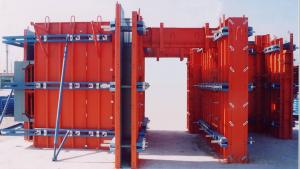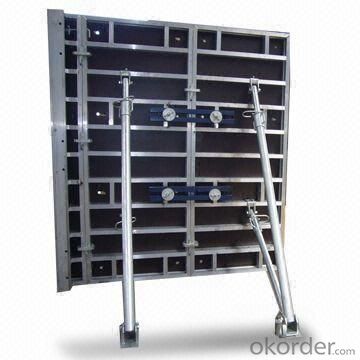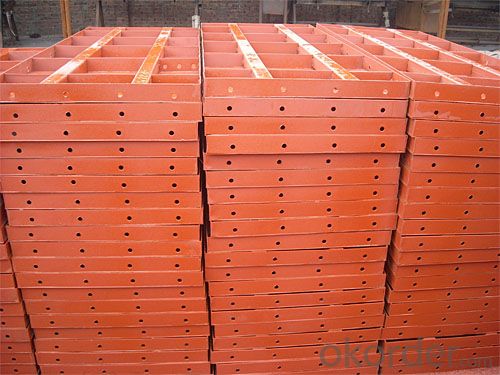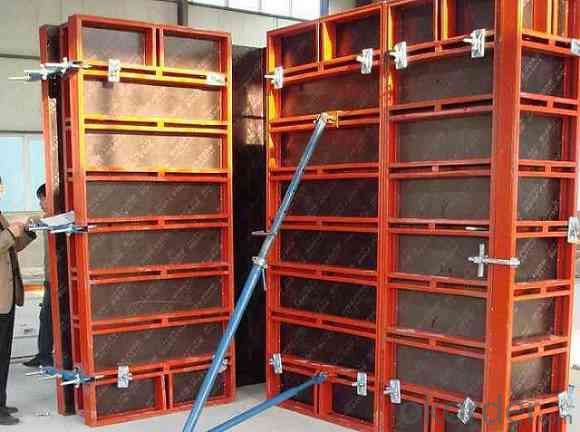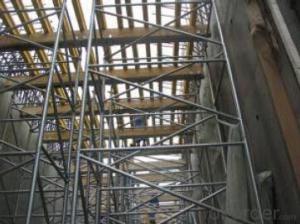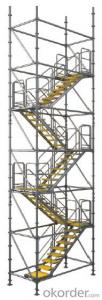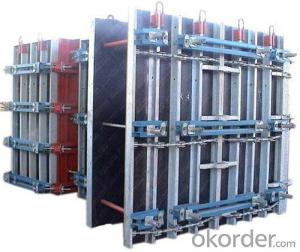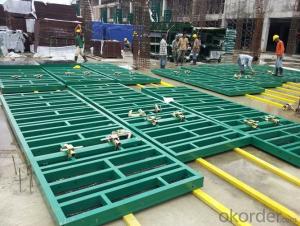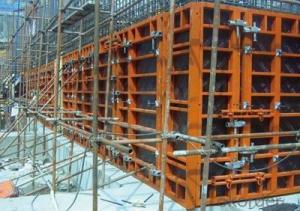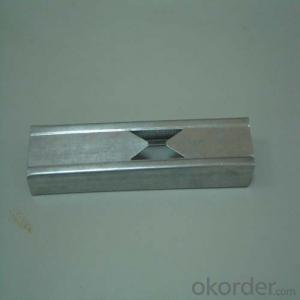Light Steel Frame Formwork from CNBM China
- Loading Port:
- Shanghai
- Payment Terms:
- TT OR LC
- Min Order Qty:
- 100 m.t.
- Supply Capability:
- 10000 m.t./month
OKorder Service Pledge
OKorder Financial Service
You Might Also Like
Formwork system
1. CNBM Universal Panel Formwork System consists of steel frame, plywood panel, push-pull prop, scaffold bracket, alignment coupler, compensation waler, tie rod, lifting hook, etc.
2. Plywood panels could be Wisa -form or homemade plywood with high quality. The steel frames therein are made of special cold roll-forming steel, no waler, with the weight of 64kg/m2 so as to easy to carry.
3. The connection between panels adopts alignment coupler rather than those of bolts or ‘‘U’’ clips which are low efficient and complicated so that it greatly improves the working efficiency.
4. Compensation water strengthens its integrate rigidity at panel connection location.
5. High turnover, easy operation, reasonable load, convenient storage and transportation, low aggregate costs.
6. CNBM Universal Panel Formwork System completely makes the formwork implementation, mechanization, and standardization come true, in other words, an ordinary tool, for example a hammer, is nough to finish the erection work efficiently.
Slab Forms Products
1. Quick Info
a. Model: Slab Formwork (pure steel, electrophoretic coated)
b. Application: used together with plywood for concrete form.
d. Load Capacity: 3500kg per s.q.m.(whole system)
e. Installation: A group of 4 workers can erect 300s.q.m in 8 hours.
Type | Length*Width(mm) | ||
L600 | 600*600 | 600*1200 | 600*3000 |
L950 | 950*600 | 950*1200 | 950*3000 |
L1200 | 1200*600 | 1200*1200 | 1200*3000 |
L1500 | 1500*600 | 1500*1200 | 1500*3000 |
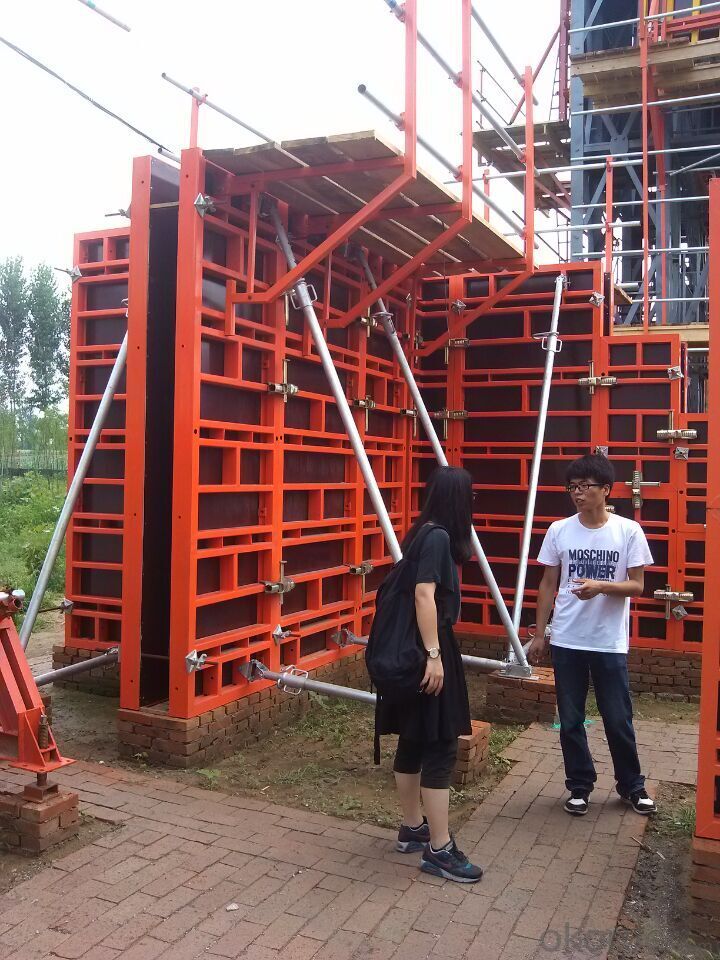
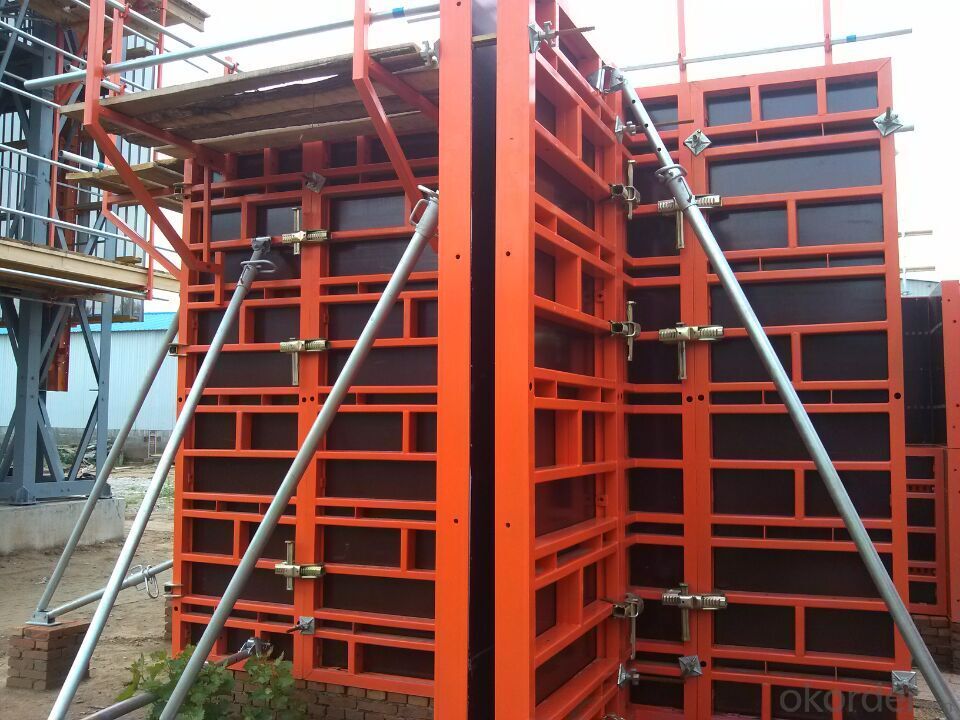
- Q: What are the common challenges faced during steel formwork installation?
- During steel formwork installation, one often encounters various common challenges. These challenges may differ depending on the specific project and site conditions. Here are some of the most prevalent challenges: 1. Precise alignment: Achieving accurate alignment of steel formwork panels can be difficult, particularly in large and intricate structures. It is crucial to ensure proper alignment for maintaining the stability and integrity of the formwork system. 2. Leveling and plumbing: Formwork must be level and plumb to ensure accurate concrete pouring as per the desired specifications. This task can be challenging, especially when working on uneven or sloping surfaces. 3. Formwork stability: To prevent movement or collapse during concrete pouring, steel formwork needs to be stable and securely anchored. Ensuring proper anchorage and stability can be challenging, particularly in areas with high wind loads or seismic activity. 4. Coordination of reinforcement placement: Installing steel formwork often involves coordinating with other trades, such as reinforcing steel installers. Challenges may arise in ensuring proper placement of reinforcement within the formwork, including sufficient clearance for concrete cover and appropriate spacing between bars. 5. Formwork removal: After the concrete has cured, the formwork needs to be removed without causing any damage to the concrete surface. This process can be challenging, especially when dealing with complex shapes or intricate details. 6. Reusability and maintenance: Steel formwork is designed to be reusable, but proper maintenance and care are necessary for its longevity. Challenges can arise in maintaining the formwork in good condition, especially when exposed to harsh weather conditions or rough handling. 7. Safety considerations: Steel formwork installation involves working at heights and handling heavy materials, which can pose safety risks. Challenges may include ensuring worker safety, implementing appropriate fall protection measures, and adhering to safety regulations and guidelines. In conclusion, steel formwork installation is a demanding and complex process that requires meticulous planning, coordination, and attention to detail. Overcoming these common challenges is vital for the successful completion of any construction project.
- Q: How does steel formwork affect the overall construction site safety?
- Steel formwork can significantly enhance overall construction site safety. Its strength and durability ensure stability and structural integrity during concrete pouring and curing processes. The use of steel formwork reduces the risk of formwork collapse or failure, which can cause serious accidents and injuries. Additionally, steel formwork's fire-resistant properties provide an added layer of safety, minimizing the potential for fire-related incidents. Overall, steel formwork promotes a safer construction site by reducing potential hazards and enhancing the structural stability of the project.
- Q: What are the main components of a steel formwork system?
- The main components of a steel formwork system typically include panels, connectors, clamps, pins, and wedges.
- Q: Can steel formwork be used for high-rise buildings?
- Yes, steel formwork can be used for high-rise buildings. Steel formwork offers several advantages such as durability, strength, and flexibility, making it suitable for large and complex structures like high-rise buildings. It can withstand the pressure exerted by concrete, ensuring structural stability during the construction process. Additionally, steel formwork allows for smooth and precise concrete finishing, facilitating the construction of high-quality, aesthetically appealing high-rise buildings.
- Q: How does steel formwork contribute to the overall sustainability of a structure?
- There are several ways in which steel formwork contributes to the overall sustainability of a structure. To begin with, steel is a highly durable material that can withstand extreme weather conditions and resist corrosion. This means that steel formwork can be used multiple times, reducing the necessity of manufacturing new formwork for each construction project. By decreasing the demand for new materials, steel formwork helps to conserve natural resources and minimize the environmental impact associated with extracting and producing new materials. Moreover, steel formwork enables efficient and accurate construction processes. Its strength and rigidity make it capable of supporting heavy loads and providing stability during concrete pouring. This leads to quicker construction times, reducing labor costs and the use of construction equipment. The efficiency and precision provided by steel formwork contribute to the overall sustainability of a structure by conserving energy and reducing waste. Furthermore, steel formwork is a versatile and flexible choice that can be easily adjusted or modified to meet changing construction needs. This adaptability allows for the reuse of formwork in different projects, reducing the amount of waste generated. Additionally, steel formwork can be recycled at the end of its lifespan, contributing to the circular economy by decreasing landfill waste and minimizing the environmental impact associated with disposal. In conclusion, steel formwork promotes sustainability in construction by decreasing the need for new materials, conserving energy, minimizing waste, and facilitating efficient construction processes. Its durability, reusability, adaptability, and recyclability make it an environmentally friendly option that contributes to the long-term sustainability of structures.
- Q: Can steel formwork be used for both single-storey and multi-storey buildings?
- Indeed, the utilization of steel formwork is applicable for single-storey and multi-storey constructions alike. This flexible method permits effortless modifications and tailoring to accommodate diverse building dimensions and configurations. With its exceptional robustness, endurance, and steadfastness, steel formwork proves to be a suitable choice for erecting both single-storey edifices and multi-storey complexes. As a result, the implementation of steel formwork facilitates swifter construction while ensuring a polished and top-notch appearance for concrete structures. Furthermore, the reusability aspect of steel formwork renders it a cost-effective and sustainable option for both single-storey and multi-storey building projects.
- Q: What are the different cost considerations associated with steel formwork?
- When planning a construction project, it is important to consider various cost factors related to steel formwork. First and foremost, the initial expense of purchasing or renting steel formwork should be taken into consideration. Steel formwork tends to be pricier compared to other options like timber or plastic. However, it is worth noting that steel formwork is durable and has a longer lifespan, which can offset the initial cost over time. Furthermore, there are labor costs involved in assembling and dismantling the steel formwork. Skilled labor is required for proper installation and removal, which may result in additional expenses. Nevertheless, steel formwork is typically quicker to set up and dismantle than other types of formwork, potentially reducing labor costs. Maintenance and repair costs are another important consideration. Although steel formwork is known for its durability, occasional maintenance or repairs may be necessary to ensure optimal performance. This can include tasks such as cleaning, painting, or replacing damaged components. It is crucial to include these maintenance costs in the overall project budget. In addition, transportation costs should be taken into account when using steel formwork. Due to its heavy and bulky nature, special transportation arrangements are required, resulting in higher transportation expenses compared to lighter and more compact formwork alternatives. Lastly, the cost of formwork accessories, including connectors, brackets, and ties, should also be factored in. These accessories are essential for proper formwork installation and can contribute to the overall cost of utilizing steel formwork. To summarize, the cost considerations related to steel formwork involve the initial purchase or rental cost, labor costs for assembly and dismantling, maintenance and repair expenses, transportation costs, and the cost of formwork accessories. Although steel formwork may entail higher upfront costs, its durability, quick installation, and long-term lifespan can yield cost-saving benefits in the long run.
- Q: How does steel formwork contribute to the overall sustainability of the construction industry?
- Steel formwork contributes to the overall sustainability of the construction industry in several ways. Firstly, steel formwork is highly durable and can be reused multiple times, reducing the need for new materials and minimizing waste. This not only reduces the environmental impact of construction but also lowers costs for builders. Additionally, steel formwork allows for precise and efficient construction, resulting in less material wastage and overall resource savings. Lastly, the strength and versatility of steel formwork enable the construction of more durable and long-lasting structures, reducing the need for frequent repairs or replacements, which further contributes to the sustainability of the construction industry.
- Q: What are the considerations when designing steel formwork for underground structures?
- Several factors must be taken into account when designing steel formwork for underground structures. Firstly, the formwork must be able to withstand the pressure exerted by the surrounding soil. Underground structures face significant lateral and vertical loads, so the formwork must resist these forces without deforming or collapsing. Steel, with its high strength and rigidity, is an ideal material for this purpose. Secondly, the formwork should be designed for easy installation and removal. Underground construction presents challenges such as limited access and confined working spaces. Therefore, the formwork system should be modular and adjustable to fit different shapes and sizes of underground structures. This would allow for efficient construction and minimize the time and effort required for formwork installation and removal. Additionally, the formwork design should consider the ease of concrete pouring and curing. Proper placement of tie rods, formwork joints, and other structural elements is crucial to ensure smooth and even flow of concrete throughout the structure. The formwork system should also provide for ventilation and drainage to prevent water accumulation or air pockets that could compromise the structure's integrity. Moreover, safety is of utmost importance in designing steel formwork for underground structures. The formwork system should incorporate safety features like guardrails and access platforms to ensure a secure working environment for construction workers. The design should also minimize manual handling by utilizing lifting and handling equipment, reducing the risk of accidents or injuries during formwork installation and dismantling. Lastly, the formwork design should consider the project's budget and schedule constraints. While steel formwork may be more expensive than other types, cost-effective design solutions should be explored without compromising safety and performance. The formwork system should also be designed for reusability, allowing for multiple applications and reducing overall project costs. In conclusion, designing steel formwork for underground structures involves careful consideration of factors like strength, durability, ease of installation, concrete pouring, safety, and cost-effectiveness. By addressing these considerations, designers can ensure the successful construction of underground structures that meet project requirements and withstand the challenges of underground environments.
- Q: What are the different types of accessories used in steel formwork installation?
- The successful construction process relies on various accessories utilized in steel formwork installation, each serving a distinct purpose. Some commonly used accessories include the following: 1. Wedges: These secure the formwork panels and provide stability during concrete pouring. By inserting wedges between panels and tightening them, the panels remain firmly in place. 2. Ties: Essential for connecting formwork panels and maintaining desired structure shape, ties, typically made of steel, prevent bulging or shifting during pouring. 3. Formwork clamps: These join formwork components, ensuring a secure attachment. Designed to withstand concrete pressure, they keep the formwork system intact. 4. Braces: Providing additional support and stability, braces evenly distribute the load, preventing panel bending or collapse under concrete weight. 5. Scaffolding: Often used alongside steel formwork installation, scaffolding offers a safe working platform for construction tasks at higher areas of the structure. 6. Corner fillets: To create rounded corners, corner fillets guarantee a smooth finish and eliminate sharp edges. Made of flexible materials like rubber or PVC, they are easy to install and remove. 7. Formwork release agents: These agents prevent concrete adhesion to formwork surfaces by creating a thin barrier. Once the concrete has cured, the formwork can be easily removed. 8. Formwork spacers: Spacers maintain a consistent gap between formwork and reinforcement bars, ensuring proper concrete cover. They prevent corrosion and enhance structural integrity. 9. Lifting accessories: Lifting eyes or hooks safely lift and move formwork panels into position, providing a secure attachment point for cranes or lifting equipment. These examples demonstrate the various accessories employed in steel formwork installation. Each accessory is crucial for a sturdy and secure formwork system capable of withstanding concrete pressures. Choosing the appropriate accessories is essential based on the specific requirements of the construction project.
Send your message to us
Light Steel Frame Formwork from CNBM China
- Loading Port:
- Shanghai
- Payment Terms:
- TT OR LC
- Min Order Qty:
- 100 m.t.
- Supply Capability:
- 10000 m.t./month
OKorder Service Pledge
OKorder Financial Service
Similar products
Hot products
Hot Searches
